- Joined
- Feb 2, 2011
- Messages
- 2,338
ARMIES AND ENEMIES OF ANCIENT ROME
ROMAN AUXILLIARY CAVALRY
As Romans were never considered exceptionally good horsemen, and the role of the cavalry not as important in the Roman thought process, the Equitatus was generally made up of non-Roman horsemen. While they would play an important part of Legionary tactics, the Roman Cavalry was considered secondary and would remain the weakest part of the Roman Army until the very late Imperial period.
Generally, the cavalry was used as light skirmishing troops, and mounted archers whose job was to patrol, act as scouts and messengers and to provide a mobile defensive screen while the legion was massing in battle array. As in all armies throughout history, the mounted trooper was also very effective in chasing down and harassing a fleeing and panicked enemy force.
As part of the military reforms of Augustus around AD 14, the Auxilia were re-organized. They would be trained to the same standards of discipline as the legions. They were mainly drawn from a wide range of warlike peoples throughout the provinces, and would receive Roman citizenship on completion of their 25 year service. Senior officers in contrast were Roman citizens.
The Auxilia filled the tasks of patrolling, containing raids, tax collecting, and the multitude of duties of the frontier troops.
They were especially suited to garrison and local policing activities, and could also hold their own in small scale warfare.

ROMCAV-12A
ARMIES AND ENEMIES OF ANCIENT ROME,
ROMAN AUXILIARY CAVALRY
Roman Auxilia cavalry were usually heavily armored in mail and armed with a short lance, javelins, the Spatha long sword, and sometimes bows for specialist Horse archer units. These men primarily served as Medium missile cavalry for flanking, scouting, skirmish, and pursuit.
Cavalry units were known as Alae, and were made up of 16 Turmae.
A Turmae consisted of 30 troopers, and was commanded by a Decurio, and a second in command called the Duplicarius.
Cavalrymen carried Clipeus , a flat oval or hexagonal shield. These were extremely light, constructed of double or triple thickness plywood, made up of thin strips of birch.

ROMCAV-12B
ARMIES AND ENEMIES OF ANCIENT ROME,
ROMAN AUXILIARY CAVALRY
ARMIES AND ENEMIES OF GREECE AND MACEDONIA
THE ACHAEMENID PERSIAN ARMY
PERSIAN HEAVY CAVALRY
The Achaemenid Empire c. 550–330 BC, also called the First Persian Empire, was an ancient Iranian empire based in Western Asia founded by Cyrus the Great. Ranging at its greatest extent from the Balkans in the west to the Indus Valley in the east, it was larger than any previous empire in history, spanning 5.5 (or 8) million square kilometers. Incorporating various peoples of different origins and faiths, it is notable for its successful model of a centralised, bureaucratic administration (through satraps under the King of Kings), for building infrastructure such as road systems and a postal system, the use of an official language across its territories, and the development of civil services and a large professional army. The empire's successes inspired similar systems in later empires.

The Achaemenid Empire encompassed a vast and diverse range of territories, from Anatolia and Egypt to the Indus Valley. This diversity was reflected in its cavalry, which included units from various ethnic groups such as Medes, Persians, Bactrians, Scythians, and Sakas.
Each group brought its own unique style of cavalry warfare, contributing to the overall effectiveness of the Achaemenid cavalry.
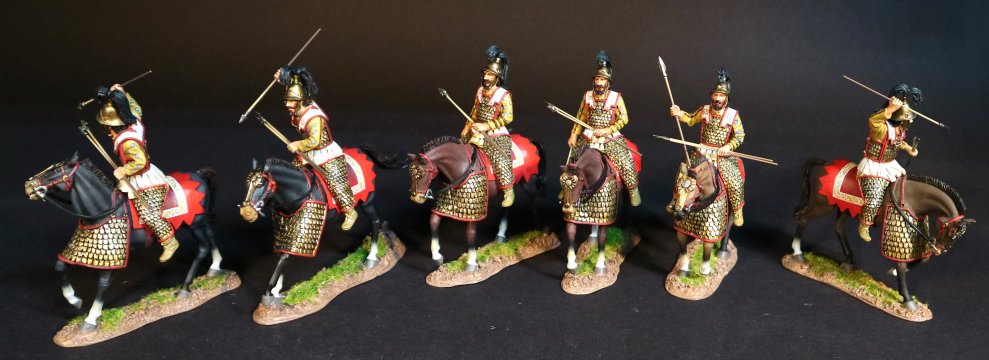

AP-70A
ARMIES AND ENEMIES OF GREECE AND MACEDONIA,
THE ACHAEMENID PERSIAN EMPIRE,
PERSIAN HEAVY CAVALRY

AP-70B
ARMIES AND ENEMIES OF GREECE AND MACEDONIA,
THE ACHAEMENID PERSIAN EMPIRE,
PERSIAN HEAVY CAVALRY
ARMIES AND ENEMIES OF GREECE AND MACEDONIA
MACEDONIAN PRODROMOI/SARISSOPHOROI
In ancient Greece the Prodromoi were skirmisher light cavalry. The translation can best be represented by “runners-before”, or “runners ahead”. This implies that these cavalry moved before the rest of the army and can best be described as intended for scouting and screening missions.

In the Macedonian army of Philip II and Alexander the Great, the cavalry unit termed as Prodromoi are sometimes referred to as Sarissophoroi, which translates as “pikemen”, or “lancers”.
This leads to the conclusion that they were armed with an uncommonly long ”xyston”. Which is believed to be as much as 14 ft long.
It is recorded that they acted as scouts reconnoitring in front of the army when it was on the march. In battle, they were used in a shock role to protect the right flank of the Companion cavalry.
After the Battle of Gaugamela, the Persian light cavalry were to take over the role of scouting duties, leaving the Macedonian Prodromoi to then buttume a purely battlefield role as shock cavalry.
At the Battle of Gaugamela, the Prodromoi under Aretes were responsible for finally routing the Persian left wing cavalry, winning the battle in this sector.
Aretas was to replace Protomachus as the commander of the Prodromii, and at Gaugamela they were to break the Massagetae heavy cavalry, with Aretes personally killing their leader.
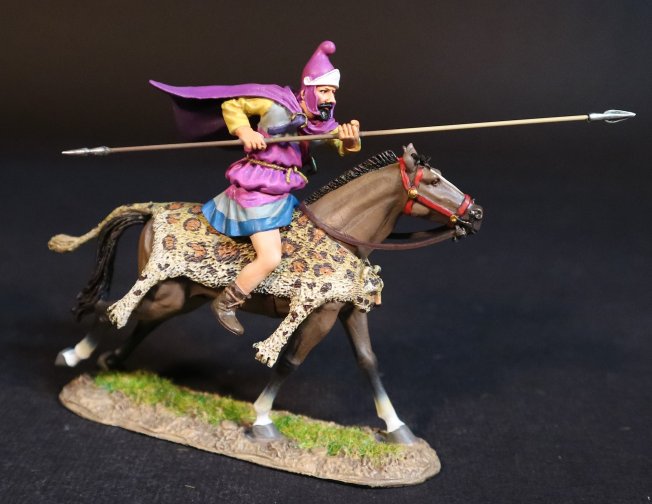
MAC-43
ARMIES AND ENEMIES OF ANCIENT GREECE AND MACEDONIA,
THE MACEDONIANS,
MACEDONIAN PRODROMOI
CRETAN ARCHERS
Cretan archers were a well known class of warrior whose specialist skills were extensively utilized by many ancient armies. They were especially valued in armies such as those of the Greek city states, notably Athens, Sparta and later Macedonia, as well as Rome as these armies could not draw upon substantial numbers of skilled archers from their native populations.

Cretan archers carried a composite bow, which consisted of a wooden core with laminated layers of sinew and horn. These bows while difficult to string and use, they gave the professional Cretan archers greater range over the simple wooden bows of the citizen levies of other armies.
Cretan archers were widely recognized as being amongst the best light missile troops in the ancient world, and as such found employment as mercenaries in many armies, including the armies of Alexander the Great.
Eurybotas was the toxarch, meaning the captain of the archers employed by Alexander.
During the retreat of the ten thousand following the Battle of Cunexa in 401 BC, Xenophon’s hoplites were able to hold off pursuing Persian troops, with the aid of the Cretan archers who formed part of the Greek mercenary army.
On this occasion the Cretans, cut off from supplies, were able to gather and reuse the spent Persian arrows while seizing bowstrings from local peasantry.
Following the conquest of Macedonia and the independent Greek city-states, Cretan archers served as auxiliaries in the Roman army, as reformed by Gaius Marius under the Republic, and later that of the Empire.
They were armed with secondary weapons for use at close quarters, included a sword and small round shields. This undoubtedly gave the Cretan warriors a huge advantage in skirmishing with other light troops.
Crete remained part of the Byzantine Empire until seized by Venice in the aftermath of the Fourth Crusade. During much of this period the island was a Theme (military province), providing both archers and sailors for the Byzantine forces.
In 1452 Venice granted specific permission for Byzantium to resume recruitment of Cretans. One of the last occasions on which Cretan archers are known to have played a significant role was as part of the garrison defending Constantinople against the Turkish army of Mehmet II in May 1453.
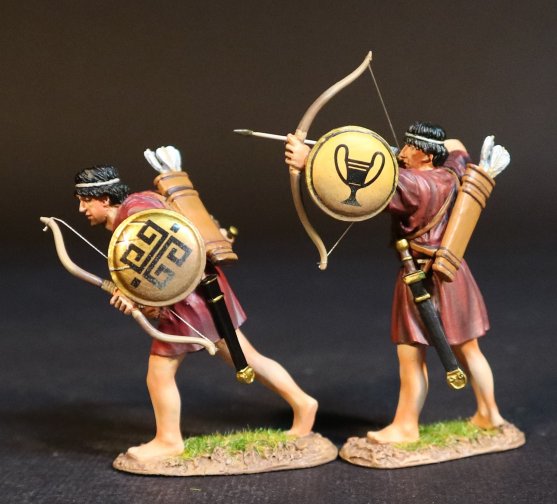
CRET-03A
ARMIES AND ENEMIES OF ANCIENT GREECE AND MACEDONIA,
CRETAN ARCHERS
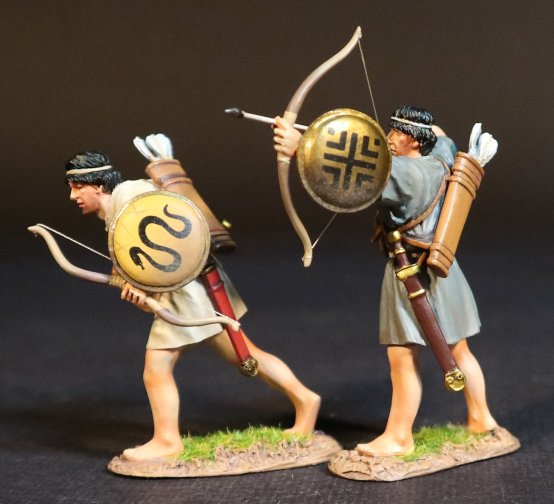
CRET-03B
ARMIES AND ENEMIES OF ANCIENT GREECE AND MACEDONIA,
CRETAN ARCHERS
PLEASE NOTE THESE ARE THE LAST SETS OF THE CRETAN ARCHERS.
THE SAMNITES
The Samnites and their relatives in central and south Italy are known as Oscans, from the name of their language.
The Samnites were the largest and most important Oscan nation, and was made up of a league of four tribes, the Pentri, Caudidi, Hirpini and Caraceni.
The Samnites fought a series of wars with Rome from 343 to 272, and were by far Rome’s most formidable Italian foe. Many Samnites were later to join Hannibal.

Livy the early Roman historian states that the Samnites fought in a loose phalanx formation in the form of a square, which was tactically flexible and more suited to their hilly terrain.
The Greek style phalanx was a formidable weapon especially from the front. But it was not flexible and once in contact with the enemy was vulnerable on its unprotected flanks and rear. It also need level, open terrain for its cohesion. The Romans had used the Phalanx to great effect along the coastal plains, but war in the constricted terrain of the mountainous spine of central Italy meant the Roman phalanx was a failure. The Samnites did well in mobile warfare and were well used to mountain ambushes.

CTSM-05A
ARMIES AND ENEMIES OF ANCIENT ROME,
THE SAMNITES,
SAMNITE WARRIOR
Samnite tunics were brightly coloured and decorated, and there is little evidence of uniformity.
Their weapons included the javelin and short spear. There was a mixture of oval and round shields, and many infantry wore a distinctive cuirasse of Italian design. Small breast and backplates of leather backed bronze linked by hinged straps of similar construction passing over the shoulders and under the arms. The commonest type was the triple disc style.
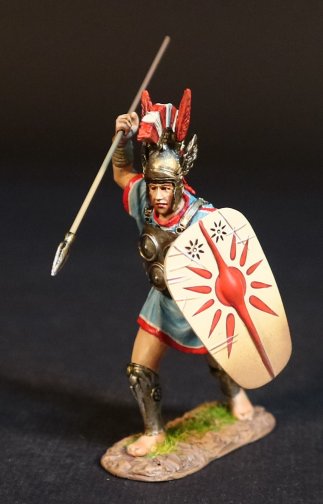
CTSM-05B
ARMIES AND ENEMIES OF ANCIENT ROME,
THE SAMNITES,
SAMNITE WARRIOR
The proportion of cavalry fielded is never mentioned in historical references, but it is buttumed it was low, as the wooded mountains would not have been good cavalry country. Like the Romans the Samnite cavalry were organized into Turmae.
Many paintings show warriors carrying spears over their shoulders with bright cloths hanging from them. These are often interpreted as flags, but it is believed that they were tunics and belts. These represent trophies taken from the dead or captured enemy who had been stripped, which was a common practice in both Italy and Greece.
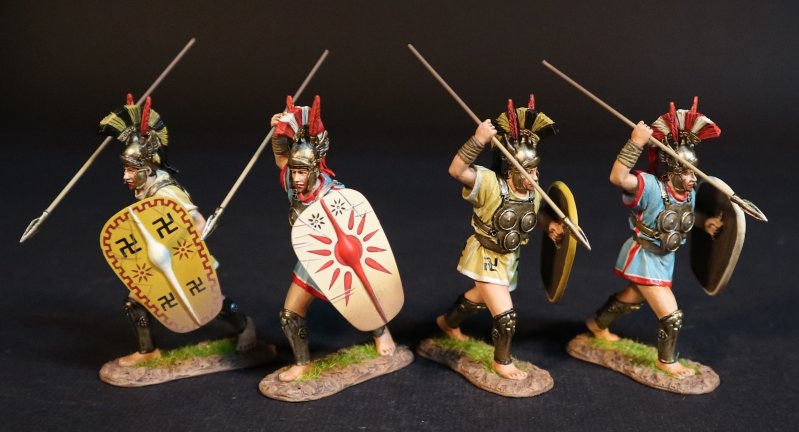
CTSM-05N
ARMIES AND ENEMIES OF ANCIENT ROME,
THE SAMNITES,
SAMNITE WARRIORS
**PLEASE CONTACT YOUR LOCAL DEALER TO PLACE YOUR PRE-ORDERS**
ROMAN AUXILLIARY CAVALRY
As Romans were never considered exceptionally good horsemen, and the role of the cavalry not as important in the Roman thought process, the Equitatus was generally made up of non-Roman horsemen. While they would play an important part of Legionary tactics, the Roman Cavalry was considered secondary and would remain the weakest part of the Roman Army until the very late Imperial period.
Generally, the cavalry was used as light skirmishing troops, and mounted archers whose job was to patrol, act as scouts and messengers and to provide a mobile defensive screen while the legion was massing in battle array. As in all armies throughout history, the mounted trooper was also very effective in chasing down and harassing a fleeing and panicked enemy force.
As part of the military reforms of Augustus around AD 14, the Auxilia were re-organized. They would be trained to the same standards of discipline as the legions. They were mainly drawn from a wide range of warlike peoples throughout the provinces, and would receive Roman citizenship on completion of their 25 year service. Senior officers in contrast were Roman citizens.
The Auxilia filled the tasks of patrolling, containing raids, tax collecting, and the multitude of duties of the frontier troops.
They were especially suited to garrison and local policing activities, and could also hold their own in small scale warfare.

ROMCAV-12A
ARMIES AND ENEMIES OF ANCIENT ROME,
ROMAN AUXILIARY CAVALRY
Roman Auxilia cavalry were usually heavily armored in mail and armed with a short lance, javelins, the Spatha long sword, and sometimes bows for specialist Horse archer units. These men primarily served as Medium missile cavalry for flanking, scouting, skirmish, and pursuit.
Cavalry units were known as Alae, and were made up of 16 Turmae.
A Turmae consisted of 30 troopers, and was commanded by a Decurio, and a second in command called the Duplicarius.
Cavalrymen carried Clipeus , a flat oval or hexagonal shield. These were extremely light, constructed of double or triple thickness plywood, made up of thin strips of birch.

ROMCAV-12B
ARMIES AND ENEMIES OF ANCIENT ROME,
ROMAN AUXILIARY CAVALRY
ARMIES AND ENEMIES OF GREECE AND MACEDONIA
THE ACHAEMENID PERSIAN ARMY
PERSIAN HEAVY CAVALRY
The Achaemenid Empire c. 550–330 BC, also called the First Persian Empire, was an ancient Iranian empire based in Western Asia founded by Cyrus the Great. Ranging at its greatest extent from the Balkans in the west to the Indus Valley in the east, it was larger than any previous empire in history, spanning 5.5 (or 8) million square kilometers. Incorporating various peoples of different origins and faiths, it is notable for its successful model of a centralised, bureaucratic administration (through satraps under the King of Kings), for building infrastructure such as road systems and a postal system, the use of an official language across its territories, and the development of civil services and a large professional army. The empire's successes inspired similar systems in later empires.

The Achaemenid Empire encompassed a vast and diverse range of territories, from Anatolia and Egypt to the Indus Valley. This diversity was reflected in its cavalry, which included units from various ethnic groups such as Medes, Persians, Bactrians, Scythians, and Sakas.
Each group brought its own unique style of cavalry warfare, contributing to the overall effectiveness of the Achaemenid cavalry.


AP-70A
ARMIES AND ENEMIES OF GREECE AND MACEDONIA,
THE ACHAEMENID PERSIAN EMPIRE,
PERSIAN HEAVY CAVALRY

AP-70B
ARMIES AND ENEMIES OF GREECE AND MACEDONIA,
THE ACHAEMENID PERSIAN EMPIRE,
PERSIAN HEAVY CAVALRY
ARMIES AND ENEMIES OF GREECE AND MACEDONIA
MACEDONIAN PRODROMOI/SARISSOPHOROI
In ancient Greece the Prodromoi were skirmisher light cavalry. The translation can best be represented by “runners-before”, or “runners ahead”. This implies that these cavalry moved before the rest of the army and can best be described as intended for scouting and screening missions.

In the Macedonian army of Philip II and Alexander the Great, the cavalry unit termed as Prodromoi are sometimes referred to as Sarissophoroi, which translates as “pikemen”, or “lancers”.
This leads to the conclusion that they were armed with an uncommonly long ”xyston”. Which is believed to be as much as 14 ft long.
It is recorded that they acted as scouts reconnoitring in front of the army when it was on the march. In battle, they were used in a shock role to protect the right flank of the Companion cavalry.
After the Battle of Gaugamela, the Persian light cavalry were to take over the role of scouting duties, leaving the Macedonian Prodromoi to then buttume a purely battlefield role as shock cavalry.
At the Battle of Gaugamela, the Prodromoi under Aretes were responsible for finally routing the Persian left wing cavalry, winning the battle in this sector.
Aretas was to replace Protomachus as the commander of the Prodromii, and at Gaugamela they were to break the Massagetae heavy cavalry, with Aretes personally killing their leader.

MAC-43
ARMIES AND ENEMIES OF ANCIENT GREECE AND MACEDONIA,
THE MACEDONIANS,
MACEDONIAN PRODROMOI
CRETAN ARCHERS
Cretan archers were a well known class of warrior whose specialist skills were extensively utilized by many ancient armies. They were especially valued in armies such as those of the Greek city states, notably Athens, Sparta and later Macedonia, as well as Rome as these armies could not draw upon substantial numbers of skilled archers from their native populations.

Cretan archers carried a composite bow, which consisted of a wooden core with laminated layers of sinew and horn. These bows while difficult to string and use, they gave the professional Cretan archers greater range over the simple wooden bows of the citizen levies of other armies.
Cretan archers were widely recognized as being amongst the best light missile troops in the ancient world, and as such found employment as mercenaries in many armies, including the armies of Alexander the Great.
Eurybotas was the toxarch, meaning the captain of the archers employed by Alexander.
During the retreat of the ten thousand following the Battle of Cunexa in 401 BC, Xenophon’s hoplites were able to hold off pursuing Persian troops, with the aid of the Cretan archers who formed part of the Greek mercenary army.
On this occasion the Cretans, cut off from supplies, were able to gather and reuse the spent Persian arrows while seizing bowstrings from local peasantry.
Following the conquest of Macedonia and the independent Greek city-states, Cretan archers served as auxiliaries in the Roman army, as reformed by Gaius Marius under the Republic, and later that of the Empire.
They were armed with secondary weapons for use at close quarters, included a sword and small round shields. This undoubtedly gave the Cretan warriors a huge advantage in skirmishing with other light troops.
Crete remained part of the Byzantine Empire until seized by Venice in the aftermath of the Fourth Crusade. During much of this period the island was a Theme (military province), providing both archers and sailors for the Byzantine forces.
In 1452 Venice granted specific permission for Byzantium to resume recruitment of Cretans. One of the last occasions on which Cretan archers are known to have played a significant role was as part of the garrison defending Constantinople against the Turkish army of Mehmet II in May 1453.

CRET-03A
ARMIES AND ENEMIES OF ANCIENT GREECE AND MACEDONIA,
CRETAN ARCHERS

CRET-03B
ARMIES AND ENEMIES OF ANCIENT GREECE AND MACEDONIA,
CRETAN ARCHERS
PLEASE NOTE THESE ARE THE LAST SETS OF THE CRETAN ARCHERS.
THE SAMNITES
The Samnites and their relatives in central and south Italy are known as Oscans, from the name of their language.
The Samnites were the largest and most important Oscan nation, and was made up of a league of four tribes, the Pentri, Caudidi, Hirpini and Caraceni.
The Samnites fought a series of wars with Rome from 343 to 272, and were by far Rome’s most formidable Italian foe. Many Samnites were later to join Hannibal.

Livy the early Roman historian states that the Samnites fought in a loose phalanx formation in the form of a square, which was tactically flexible and more suited to their hilly terrain.
The Greek style phalanx was a formidable weapon especially from the front. But it was not flexible and once in contact with the enemy was vulnerable on its unprotected flanks and rear. It also need level, open terrain for its cohesion. The Romans had used the Phalanx to great effect along the coastal plains, but war in the constricted terrain of the mountainous spine of central Italy meant the Roman phalanx was a failure. The Samnites did well in mobile warfare and were well used to mountain ambushes.

CTSM-05A
ARMIES AND ENEMIES OF ANCIENT ROME,
THE SAMNITES,
SAMNITE WARRIOR
Samnite tunics were brightly coloured and decorated, and there is little evidence of uniformity.
Their weapons included the javelin and short spear. There was a mixture of oval and round shields, and many infantry wore a distinctive cuirasse of Italian design. Small breast and backplates of leather backed bronze linked by hinged straps of similar construction passing over the shoulders and under the arms. The commonest type was the triple disc style.

CTSM-05B
ARMIES AND ENEMIES OF ANCIENT ROME,
THE SAMNITES,
SAMNITE WARRIOR
The proportion of cavalry fielded is never mentioned in historical references, but it is buttumed it was low, as the wooded mountains would not have been good cavalry country. Like the Romans the Samnite cavalry were organized into Turmae.
Many paintings show warriors carrying spears over their shoulders with bright cloths hanging from them. These are often interpreted as flags, but it is believed that they were tunics and belts. These represent trophies taken from the dead or captured enemy who had been stripped, which was a common practice in both Italy and Greece.

CTSM-05N
ARMIES AND ENEMIES OF ANCIENT ROME,
THE SAMNITES,
SAMNITE WARRIORS
**PLEASE CONTACT YOUR LOCAL DEALER TO PLACE YOUR PRE-ORDERS**

